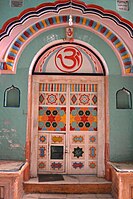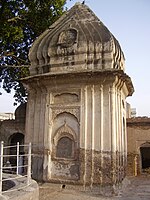Hinduism in Khyber Pakhtunkhwa
Animists | |
| Languages | |
|---|---|
| Sanskrit (Sacred) Urdu, Pashto, Hindko, Saraiki, Punjabi |
| Year | Pop. | ±% |
|---|---|---|
| 1881 | 111,892 | — |
| 1891 | 118,881 | +6.2% |
| 1901 | 128,617 | +8.2% |
| 1911 | 119,942 | −6.7% |
| 1921 | 149,881 | +25.0% |
| 1931 | 142,977 | −4.6% |
| 1941 | 180,321 | +26.1% |
| 1951 | 2,432 | −98.7% |
| 1998 | 5,368 | +120.7% |
| 2017 | 5,392 | +0.4% |
| Sources: Census in Pakistan & Census of India [1][2][3]: 12–21 [4]: 22 [5]: 373 [6]: 344 | ||
Though having a small population, the Hindu culture has had a very significant element in the history of Khyber Pakhtunkhwa.
In the final census conducted prior to partition
History
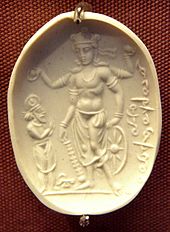
Ancient era
The
Medieval era



In the first millennium CE, the Khyber Pakhtunkhwa region was ruled by Hindu-Buddhist Turk Shahi and Hindu Shahi dynasties.[citation needed] During the rule of the Shahis, the Khyber Pakhtunkhwa region was a center of trade. Textiles, gems, and perfumes, as well as other goods had been exported west and into central Asia.
The Shahis were known for their many Hindu temples. These temples were mostly looted and destroyed by later invaders. The ruins of these temples can be found at
Over time, Mahmud of Ghazni had pushed further into the subcontinent, as far as east as modern day
Colonial era
During the colonial era, census reports detailed that much of the indigenous Hindu population in the
In a similar manner to the
"The names returned as those of
castes have been relaxed... any distinct caste organization is virtually non-existent in rural areas. Outside the towns Hindus still live in a condition of dependance on their Mohammadan overlords. The Arora, the Khatri, or the Bhatia shop-keeper in a village is a hamsaya of the proprietors of the land; that is to say, he lives rent free in a house which does not belong to him, and in return for this, and for being allowed to reside unmolested in the village, has to render certain services to his protectors." [15]: 93–94— Excerpts from the Census of India (North-West Frontier Province), 1911 AD
Traditionally, Hindu members of the castes and tribes who were indigenous to the frontier regions of the
"In Hazara, the northernmost district of the Province, the proportion of Hindus to the total population is the smallest (4 per cent). The reason is not far to seek. The Hindus in the Province, are, in the main, dependent upon trade and military service, as the bulk of the Musalman population is supported by agriculture. There are no important centres of trade in Hazara, nor has it any turbulent tribes on its border, as is the case with all trans-Indus districts. The permanent location of certain Gurkha regiments at Abbottabad may be traced to climatic considerations rather than to any military necessity. From the military point of view as well as from the point of view of trade and commerce, Hazara occupies the least important position in the Province and this accounts for the small percentage of Hindu population in this district." [6]: 95
"Next to Dera Ismail Khan, Bannu contains the largest proportion of Hindus and the head-quarters town, Edwardesabad [Bannu], is the only town in the Province where the bulk of the population is Hindu. Practically the whole of internal trade of the district and external trade with the Tochi Agency and through it with Afghanistan is in the hands of the Hindus, who have therefore settled in large numbers at Edwardesabad [Bannu] which is a growing town." [6]: 97
"Dera Ismail Khan has always had the distinction of having the largest proportion of Hindu population. During the last decade the Hindus of no other district showed such improvement in numbers as was noticed in this district (37 per cent). The Powinda trade through the Gomal Pass, which is entirely in the hands of Hindus, is mainly responsible for the large indigenous Hindu population of the district. About 43 per cent of the total Hindus in the district reside at the head-quarters town, which is the chief centre of the Powinda trade." [6]: 98— Excerpts from the Census of India (North-West Frontier Province), 1921 AD
Immediately prior to 1947 Partition of India, the British held a referendum in the NWFP to allow voters to choose between joining India or Pakistan and 99.02% votes were cast in favor of Pakistan.[16] After the independence of Pakistan in 1947, most of the Hindus left for India.[17]
Demographics
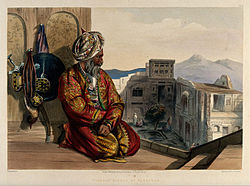
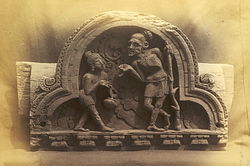


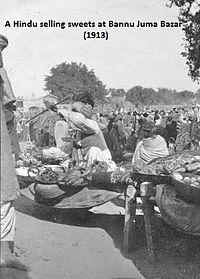

During the colonial era (British India), prior to the partition in 1947, decadal censuses enumerated religion in North-West Frontier Province, and not in the Federally Administered Tribal Areas. Both administrative divisions later amalgamated to become Khyber Pakhtunkhwa.
Colonial era
According to the 1921 census, the Hindu population in North-West Frontier Province (part of the region that composes contemporary Khyber Pakhtunkhwa) was approximately 149,881, or 6.7 percent of the total population.[6]: 344–345
According to the 1941 census, the Hindu population in North-West Frontier Province (part of the region that composes contemporary Khyber Pakhtunkhwa) was approximately 180,321, or 5.9 percent of the total population.[4]: 22
Districts
At the district level in North-West Frontier Province, as per the 1921 census, the largest Hindu concentrations existed in Dera Ismail Khan District (Hindus formed 15.08 percent of the total population and numbered 39,311 persons), Bannu District (9.53 percent or 23,509 persons), and Kohat District (6.01 percent or 12,879 persons).[6]: 344–346
At the district level in North-West Frontier Province, as per the 1941 census, the largest Hindu concentrations existed in Dera Ismail Khan District (Hindus formed 13.14 percent of the total population and numbered 39,167 persons), Bannu District (10.63 percent or 31,471 persons), and Kohat District (6.06 percent or 17,527 persons).
| District | 1921[6]: 344–346 | 1931[5]: 373–375 | 1941[4]: 22–23 | |||
|---|---|---|---|---|---|---|
| Pop. | % | Pop. | % | Pop. | % | |
| Peshawar District | 48,144 | 5.31% | 42,321 | 4.34% | 51,212 | 6.01% |
| Dera Ismail Khan District | 39,311 | 15.08% | 35,822 | 13.07% | 39,167 | 13.14% |
| Hazara District | 26,038 | 4.18% | 25,260 | 3.77% | 30,267 | 3.8% |
| Bannu District | 23,509 | 9.53% | 26,181 | 9.69% | 31,471 | 10.63% |
| Kohat District | 12,879 | 6.01% | 13,393 | 5.67% | 17,527 | 6.06% |
| Mardan District | — | — | — | — | 10,677 | 2.11% |
| Total Hindus | 149,881 | 6.66% | 142,977 | 5.9% | 180,321 | 5.94% |
| Total Population | 2,251,340 | 100% | 2,425,076 | 100% | 3,038,067 | 100% |
Tehsils
At the
At the
| Tehsil | 1921[6]: 510–516 | 1931[5]: 393–396 | 1941[4]: 30 | |||
|---|---|---|---|---|---|---|
| Pop. | % | Pop. | % | Pop. | % | |
Peshawar Tehsil
|
25,414 | 9.65% | 23,538 | 8.44% | 33,551 | 8.62% |
| Dera Ismail Khan Tehsil | 24,685 | 15.82% | 25,982 | 15.19% | 30,065 | 16.03% |
| Bannu Tehsil | 16,130 | 11.32% | 17,789 | 10.99% | 24,517 | 13.07% |
| Abbottabad Tehsil | 13,580 | 5.85% | 13,378 | 5.27% | 17,558 | 5.69% |
| Nowshera Tehsil | 10,638 | 7.15% | 9,271 | 5.77% | 15,128 | 6.93% |
| Tank Tehsil | 10,224 | 17.14% | 5,109 | 9.98% | 5,279 | 9.48% |
| Marwat Tehsil | 7,379 | 7.08% | 8,392 | 7.74% | 6,954 | 6.42% |
| Haripur Tehsil | 7,362 | 4.54% | 7,016 | 4.13% | 7,278 | 3.87% |
| Mardan Tehsil | 6,846 | 3.99% | 5,941 | 2.99% | 8,709 | 2.91% |
| Kohat Tehsil | 6,415 | 8.31% | 7,615 | 8.62% | 9,156 | 7.99% |
| Mansehra Tehsil | 4,592 | 2.29% | 4,308 | 2.06% | 4,910 | 2.02% |
| Kulachi Tehsil | 4,402 | 9.76% | 4,731 | 9.12% | 3,823 | 6.97% |
| Hangu Tehsil | 4,225 | 9.45% | 2,990 | 6.65% | 5,909 | 9.52% |
| Swabi Tehsil | 3,063 | 1.92% | 1,426 | 0.9% | 1,968 | 0.95% |
| Teri Tehsil | 2,239 | 2.43% | 2,788 | 2.71% | 2,462 | 2.18% |
| Charsadda Tehsil | 2,183 | 1.33% | 2,145 | 1.21% | 2,533 | 1.04% |
| Amb Tehsil | 440 | 2.02% | 509 | 1.63% | 433 | 0.9% |
| Phulra Tehsil | 64 | 1.12% | 49 | 0.74% | 88 | 1.01% |
| Total Hindus | 149,881 | 6.66% | 142,977 | 5.9% | 180,321 | 5.94% |
| Total Population | 2,251,340 | 100% | 2,425,076 | 100% | 3,038,067 | 100% |
Cities
According to the 1921 census, the Hindu population in urban portions of
According to the 1941 census, the Hindu population in urban portions of
| City/Urban Area | 1921[6]: 340–342 | 1931[5]: 257–259 | 1941[4]: 19 | |||
|---|---|---|---|---|---|---|
| Pop. | % | Pop. | % | Pop. | % | |
| Peshawar[d] | 20,981 | 20.09% | 21,973 | 18.03% | 31,630 | 18.24% |
| Dera Ismail Khan[d] | 17,077 | 43.41% | 16,761 | 41.56% | 22,815 | 44.47% |
| Bannu[d] | 13,222 | 59.4% | 15,036 | 49.24% | 22,175 | 57.59% |
| Abbottabad[d] | 7,346 | 53.94% | 7,753 | 47.96% | 11,886 | 43.34% |
| Nowshera[e] | 6,192 | 22.32% | 4,675 | 16.14% | 9,831 | 22.33% |
| Kohat[d] | 5,796 | 20.81% | 6,709 | 19.53% | 8,250 | 18.34% |
| Tank[f] | 4,197 | 38.7% | 2,244 | 34.95% | 3,296 | 36.26% |
| Risalpur | 3,369 | 39.64% | 2,900 | 36.18% | 3,937 | 43.71% |
| Mardan[d] | 3,220 | 29.46% | 3,605 | 13.72% | 5,851 | 13.77% |
| Jamrud | 3,114 | 50.82% | — | — | — | — |
| Haripur | 2,636 | 44.76% | 2,693 | 35.19% | 3,113 | 33.39% |
| Lakki[f] | 2,543 | 34.02% | 2,805 | 36.41% | 3,710 | 36.58% |
| Kulachi[f] | 2,162 | 27.38% | 2,182 | 25.9% | 2,092 | 23.67% |
| Nawan Shehr[f] | 1,052 | 20.66% | 883 | 17.21% | 1,030 | 16.06% |
| Baffa[f] | 861 | 11.32% | 762 | 10.5% | 735 | 9.2% |
| Charsadda | 484 | 4.73% | 519 | 4.5% | 745 | 4.42% |
| Tangi | 314 | 3.19% | 362 | 4.17% | 444 | 3.44% |
| Cherat | 80 | 30.65% | 158 | 18.74% | 30 | 8.9% |
| Parang | 16 | 0.16% | 16 | 0.16% | 2 | 0.01% |
| Mansehra | — | — | 1,091 | 18.88% | 1,699 | 16.63% |
| Kot Najibullah | — | — | — | — | 929 | 17.48% |
| Utmanzai | — | — | — | — | 182 | 1.8% |
| Total Urban Hindu Population | 94,662 | 28.19% | 93,127 | 24.12% | 134,382 | 24.34% |
| Total Urban Population | 335,849 | 100% | 386,177 | 100% | 552,193 | 100% |
Modern era
According to the
In the
Community life
In
The
Mansehra Shiv Temple is one of the oldest Hindu temples in Pakistan that is still in existence. It is at least 2000[28] to 3000 years old.[29] Panj Tirath is another historic Hindu temple in Pakistan.[30][31] In 2020, Karak temple attack, historic Hindu temple and Samadhi in Karak district was demolished and burnt by a mob of 1,500 local Muslims led by a local Islamic cleric and the supporters of Jamiat Ulema-e-Islam party.[32][33]
Temples
See also
- Hinduism in Sindh province
- Hinduism in Balochistan
- Hinduism in Punjab Province
- Bannu District
Notes
- ^ Pre-partition populations for religious data is for North-West Frontier Province only and excludes the Federally Administered Tribal Areas (both administrative divisions later merged to form Khyber Pakhtunkhwa in 2018), as religious data was not collected in the latter region at the time.
1951, 1998, and 2017 populations for religious data combine the North-West Frontier Province and Federally Administered Tribal Areas, both administrative divisions which later merged to form Khyber Pakhtunkhwa in 2018. - ^ Temple D—per Meiser's designations—near the main gateway to the north. The complex has four temples.
- ^ Temple B, per Meiser's designations. The complex has eight temples.
- ^ a b c d e f Includes total Municipality and Cantonment population.
- Notified areapopulation.
- ^ Notified areapopulation.
References
- ^ "TABLE 9 - POPULATION BY SEX, RELIGION AND RURAL/URBAN" (PDF). Retrieved 9 February 2023.
- ^ "Population Distribution by Religion, 1998 Census" (PDF). Retrieved 9 February 2023.
- ^ "CENSUS OF PAKISTAN, 1951 POPULATION ACCORDING TO RELIGION TABLE 6" (PDF). Retrieved 9 February 2023.
- ^ JSTOR saoa.crl.28215543. Retrieved 24 February 2024.
- ^ JSTOR saoa.crl.25793233. Retrieved 24 February 2024.
- ^ JSTOR saoa.crl.25430163. Retrieved 24 February 2024.
- ^ Buddhism in Central Asia by Baij Nath Puri p.131
- ^ "Imperial Gazetteer2 of India, Volume 19, page 148 – Imperial Gazetteer of India – Digital South Asia Library". Retrieved 4 June 2021.
- ^ Bhattacharya, Avijeet. Journeys on the Silk Road Through Ages. Zorba. p. 187.
- ^ a b (Wynbrandt 2009, pp. 52–54)
- ^ (Wink 1991, p. 125)
- ^ (Holt et al 1977, p. 3)
- ^ (Wynbrandt 2009, pp. 52–55)
- ^ (Tomsen 2013, p. 56)
- ^ a b c d e f g "CENSUS OF INDIA, 1911 VOLUME XIII NORTH-WEST FRONTIER PROVINCE". Retrieved 10 February 2023.
- ISBN 9780275978785. Retrieved 18 April 2015.
- ISBN 978-0-231-13847-5.
- Mohammad Murad Beg of Kunduz.
- ^ "Population Distribution by Religion, 1998 Census" (PDF). Pakistan Bureau of Statistics. Archived (PDF) from the original on 26 December 2016. Retrieved 4 June 2021.
- ^ "SALIENT FEATURES OF FINAL RESULTS CENSUS-2017" (PDF). Retrieved 4 June 2021.
- ^ "Hindu Population (PK) – Pakistan Hindu Council". Archived from the original on 15 March 2018. Retrieved 24 May 2021.
{{cite web}}: CS1 maint: unfit URL (link) - ^ "Across religious divides: A harmonious haven for Hindus in Khyber-Pakhtunkhwa". The Express Tribune. 14 October 2019.
- ^ "Sikhs and Hindu families move to Pak Punjab". NDTV. 3 May 2009.
- ^ Witzel, Michael (2004), "Kalash Religion (extract from 'The Ṛgvedic Religious System and its Central Asian and Hindukush Antecedents')" (PDF), in A. Griffiths; J. E. M. Houben (eds.), The Vedas: Texts, Language and Ritual, Groningen: Forsten, pp. 581–636
- ^ pace Fussman 1977
- ^ Akbar, Ali (4 April 2017). "Peshawar High Court orders govt to include Kalasha religion in census". Dawn. Retrieved 11 July 2017.
Kalasha, the religion followed by Kalash community, lies between Islam and an ancient form of Hinduism.
- PMID 27459054.
- ^ "Pakistan prepares to hold a major Hindu festival Maha Shivaratri". Asia. Gulf News. TNN. 17 February 2020. Retrieved 4 June 2021.
- ^ "Mansehra's Shiv temple". Fridaytimes. TNN. 14 August 2014. Retrieved 4 June 2021.
- ^ "Panj Tirath: Heritage Lost to the Ravages of Time". The Friday Times. 2019-02-15. Retrieved 2021-06-06.
- ^ Scroll Staff. "Pakistan declares ancient Hindu religious site Panj Tirath to be national heritage". Scroll.in.
- ^ "Pakistan arrests more than a dozen over Hindu temple attack". Aljazeera. 31 December 2020. Retrieved 4 June 2021.
- ^ Imtiaz Ahmad (31 December 2020). "Hindu temple in Pakistan vandalised, set on fire". Hindustan Times. Retrieved 4 June 2021.
Works cited
- P. M. Holt; Ann K. S. Lambton; ISBN 0-521-29137-2.
- Tomsen, P. (2013). The Wars of Afghanistan: Messianic Terrorism, Tribal Conflicts, and the Failures of Great Powers. PublicAffairs. ISBN 978-1-61039-412-3. Retrieved 2018-05-06.
- Wink, Andre (1991). Al- Hind: The slave kings and the Islamic conquest. E.J Brill.
- Wynbrandt, James (2009). A Brief History of Pakistan. New York: Infobase Publishing.


